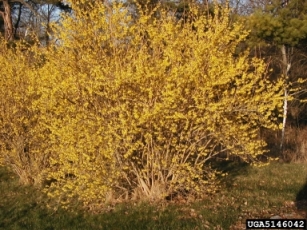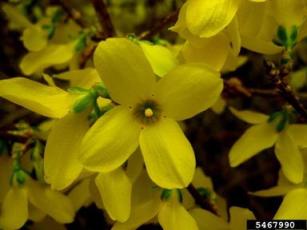Spring is right around the corner. One of my favorite plants that is an indicator that spring will be here soon is the forsythia. This shrub is one of the earliest plants to bloom in the spring for Southeast Nebraska. Its bright yellow flowers offer great relief from the drab winter.
Border Forsythia
Forsythia x intermedia, border forsythia, is the most common forsythia we plant in Nebraska. This is a great early spring blooming shrub. It grows 8 to 10 feet tall and 10 to 12 feet wide. It blooms in late February to early March and the flowers open before the leaves appear on the shrub. The flowers are 1¼ to 1½ inches long and wide, bell shaped, and clustered along the branches of the majority of the plant. The leaves are small and dark green and appear on the plant after the flowers begin to fade and last into the fall.
There are many varieties to choose from, but you need to pay attention to the hardiness of the plant. Many varieties don't bloom reliably in Nebraska. Our cold winters tend to freeze the flower buds before they can open in the spring. One good choice for Nebraska is 'Sunrise', a compact variety that only grows to 5 feet tall and wide. 'Meadowlark' is another great choice that grows to 6½ feet tall and 9 feet wide and can turn a yellow color in the fall. Other good choices include 'Northern Sun', 'Northern Gold', 'New Hampshire Gold', and 'Vermont Gold.' Forsythia can grow to be quite large and wild, so use compact varieties in small spaces such as a garden.
Growing
Plant it in full sun for maximum flower production. It prefers fertile, well-drained soils, but will tolerate most soil conditions, according to Clemson University.
Forsythia blooms on old wood early in the spring, so when necessary, prune right after flowering has finished in late spring. This consists of cutting out some of the old, less productive branches at the base of the plant, or cutting the plant all the way back. Blooming forsythia branches can be used as a cut flower in an arrangement or alone.
Although forsythia shrubs offer no food resources for birds and other small wildlife creatures, they do provide some shelter. Larger forsythia plantings used as a border are a great place for wildlife to hide from other animals.
Forsythia is a great plant to be used as a border, a specimen plant, or in other areas on your landscape. This is one plant that I use as a harbinger of spring and warm weather.
Consider forsythia for your acreage - just be sure to get a variety that will flower reliably in our Nebraska climate.


